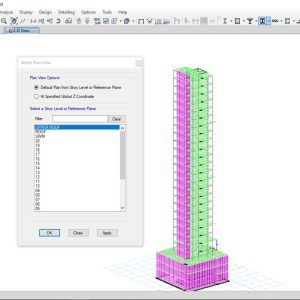-
 MS Office Professional Essential Training$200.00
MS Office Professional Essential Training$200.00 -
 Primavera P6 Professional Training Course$250.00
Primavera P6 Professional Training Course$250.00 -
Product on sale
 20+ Story High Rise BuildingOriginal price was: $39.99.$9.99Current price is: $9.99.
20+ Story High Rise BuildingOriginal price was: $39.99.$9.99Current price is: $9.99. -
 CSI SAFE Essential Training Course$250.00
CSI SAFE Essential Training Course$250.00 -
 CSI ETABS Essential Training Course$350.00
CSI ETABS Essential Training Course$350.00
TABLE OF CONTENTS
1. The structural frame
1.1. Introduction 1.2. Structural frame elements 1.2.1. Columns 1.2.2. Beams 1.2.3. Slabs 1.2.4. Staircases 1.2.5. Foundation 1.3. Structural frame loadings 1.3.1. Gravity loads 1.3.2. Seismic loads 1.3.3. Wind loading 1.4. Structural frame behaviour 1.4.1. Behaviour and reinforcement of slabs 1.4.2. Behaviour and reinforcement of beams and columns
2. The construction of the structural frame members 2.1 The materials 2.2 The formwork 2.3 Thermal insulation of structural elements 2.4 Concrete 2.4.1 General information 2.4.2 Ordering concrete 2.4.3 Concrete delivery on site 2.4.4 Concrete pumping 2.4.5 Concrete casting 2.4.6 Compacting concrete 2.4.7 Concrete curing 2.4.8 Removing the formwork 2.4.9 Self-compacting (self consolidating) concrete 2.5 The steel 2.6 Reinforcement specifications of earthquake resistant design 2.6.1 The concrete cover of the reinforcement 2.6.2 Minimum spacing between reinforcement rebars 2.6.
3 Rebar bending 2.6.4 Earthquake resistant stirrups 2.7 Industrial stirrups – stirrup cages 2.8 Standardized cross-sections of reinforced concrete elements 3. Reinforcement of structural elements 3.1 Columns 3.1.1 Lap-splices in columns rebars 3.1.2 Anchoring the reinforcement of the upper floor level 3.1.3 Reduction of the column’s section size along its height 3.1.4 Reinforcement in typical columns 3.2 Shear walls 3.2.1 General 3.2.2 Shear wall behaviour 3.2.3 Shear wall reinforcement 3.2.4 Anchoring the horizontal rebars of the shear wall body 3.2.5 Lap-splices of vertical rebars 3.2.6 Anchorage of vertical rebars 3.2.7 Starter rebars in shear walls 3.3 Vertical elements with compound shape 3.4 Beams 3.4.1 General 3.4.2 Continuous beam 3.4.3 Reinforcement placement 3.4.4 Short beam 3.4.5 Beam under torsion 3.4.6 The feasibility of concrete casting in beams 3.5 Slabs 3.5.1 One-way slab (simply supported slab) 3.5.2 Two-way slab 3.5.3 One-way slab connected to a cantilever 3.5.4 Continuous slab connected to a cantilever 3.5.5 Ribbed slabs 3.5.6 Sandwich slabs 3.5.7 Rules for the detailing of slab rebars 3.6 Staircases 3.6.1 Simply supported staircase 3.6.2 Simply supported staircase in continuation to floor slabs 3.6.3 Starter rebars in staircases 3.6.4 Staircase with landings 3.6.5 Winder staircase 3.7 Foundation 3.7.1 Spread footings 3.7.2 Frame foundation 3.7.3 Strip foundation 3.7.4 Raft foundation 3.7.5 Foundation cases
4 Quantity surveying-Cost estimate 4.1 Concrete quantity take-off 4.2 Formwork quantity take-off 4.3 Spacer quantity take-off 4.4 Reinforcement quantity take-off 4.5 Total material quantity estimates 4.6 Optimization of the reinforcement schedule 4.7 Cost estimation of the structural frame 4.8 Electronic exchange of designs – bids – orders
5 Detailing drawings of a structural frame 5.1 General 5.2 The drawings’ title block 5.3 Carpenter’s drawings 5.3.1 EXCAVATIONS and FOUNDATION FLOOR 5.3.2 FORMWORK OF THE FOUNDATION and the basement floor 5.3.3 FORMWORK of the BASEMENT SLAB 5.3.4 FORMWORK of the GROUND FLOOR SLAB 5.3.5 FORMWORK of the MEZZANINE SLAB 5.3.6 FORMWORK of the MEZZANINE SLAB with thermal insulation 5.4 Steel fixer’s drawings TABLES
-
 Turnitin Instructor with AI Detection$70.00 – $130.00
Turnitin Instructor with AI Detection$70.00 – $130.00 -
 SmartPLS 4.1 Processional | Lifetime activation key$60.00
SmartPLS 4.1 Processional | Lifetime activation key$60.00 -
 EndNote Lifetime for Windows /Mac Software Full Version$8.00 – $15.00
EndNote Lifetime for Windows /Mac Software Full Version$8.00 – $15.00 -
![EARTHQUAKE RESISTANT BUILDINGS from reinforced concrete (VOLUME A & B) The Art of Construction and the Detailing 11 IBM SPSS Statistics v30 | v29 [Lifetime Activation with key]](https://civilmdc.com/wp-content/uploads/2022/03/IBM-SPSS-30-Key-300x300.jpg) IBM SPSS Statistics v30 | v29 [Lifetime Activation with key]$15.00 – $45.00
IBM SPSS Statistics v30 | v29 [Lifetime Activation with key]$15.00 – $45.00 -
 LinkedIn ALL COURSES LIFETIME Warranty$25.00
LinkedIn ALL COURSES LIFETIME Warranty$25.00 -
Product on sale
 REF-N-WRITE | Premium Account Lifetime ActivationOriginal price was: $45.00.$22.00Current price is: $22.00.
REF-N-WRITE | Premium Account Lifetime ActivationOriginal price was: $45.00.$22.00Current price is: $22.00. -
 QuillBot’s paraphrasing tool | Premium Account 6 month | + WARRANTY$12.00
QuillBot’s paraphrasing tool | Premium Account 6 month | + WARRANTY$12.00 -
 Grammarly Premium Account 6 Month |12 month$20.00 – $35.00
Grammarly Premium Account 6 Month |12 month$20.00 – $35.00 -
 TURNIT1N Student (Plagiarism Checker) – 6 Month | 1 Year | 2 Years | 3 Years | 4 Years | LifeTime$15.00 – $200.00
TURNIT1N Student (Plagiarism Checker) – 6 Month | 1 Year | 2 Years | 3 Years | 4 Years | LifeTime$15.00 – $200.00




 Visit
Visit 
I’m interested in this book. Earthquakes afects the foundations of the main buildings.
Interested to know how the book study the traitment of especial foundations in relation sheap with the afectation of earthquakes.